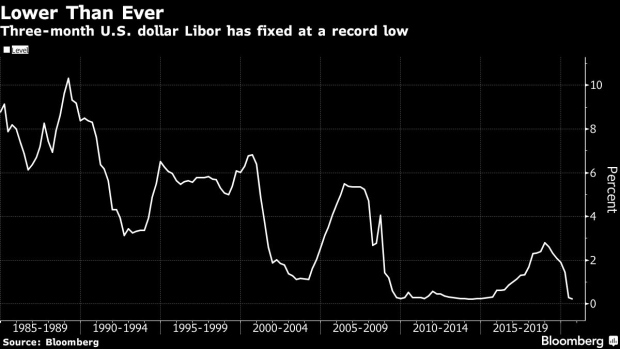Sep 22, 2020
Dollar Libor Falls to Record Low on Flood of Fed Liquidity
, Bloomberg News

(Bloomberg) -- Three-month dollar Libor hit its lowest level on record Tuesday, marking the fifth straight day of declines.
The rate, which is a key benchmark for lending between banks, fixed 0.075 basis point lower at 0.2225%, surpassing a previous all-time low set in May 2014. Extraordinary support from the Federal Reserve since the Covid-19 outbreak and economic shutdown has driven the rate down from as high as 1.45% in March.
“I think we’ve reached a steady state for Libor, but the ongoing Fed support and lack of funding needs by banks -- due to a surge in deposits post-Covid -- have helped” push the rate lower, said TD Securities strategist Gennadiy Goldberg.
The Fed’s efforts have helped bank deposits balloon -- they’re now $15.7 trillion, down just slightly from a record last month.
The monthly surge of cash from housing finance giants is probably also contributing to these latest declines in Libor.
Government-sponsored enterprises such as Fannie Mae typically receive mortgage payments around mid-month, then park them in repurchase markets -- where securities are pledged for short-term cash -- to earn interest over the following few days. That drives repo rates lower, with the knock-on effect of herding cash lenders into the higher-paying unsecured market, pressuring Libor lower.
That cash exits the market around the 24th of the month, when GSEs make principal- and interest payments to bondholders.
Read more: Libor’s Erratic Behavior Down to Mortgage Flows: Liquidity Watch
Libor’s slide may not have much further to run, provided that the recovery continues, allowing risk appetite to return.
“I don’t think there’s very much more downside in the near-term since the recovery should eventually lead bank deposits to flow out as rates remain low,” Goldberg said.
(Adds chart and context on government-sponsored enterprises cash in sixth paragraph)
©2020 Bloomberg L.P.